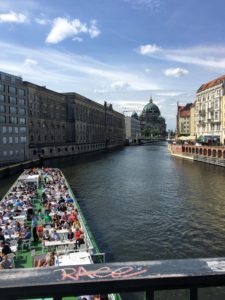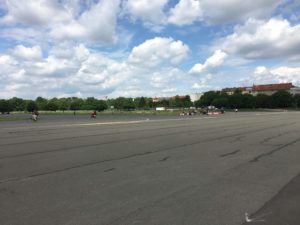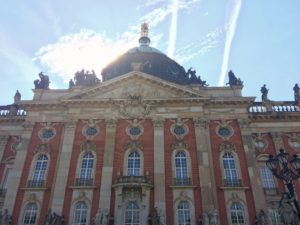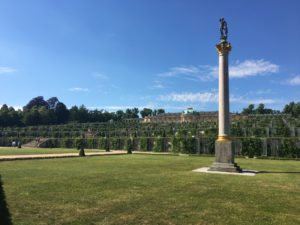
Berlin sightseers have plenty of options for boat rides around the city. Photo by Lia Norton
Here’s part two of Lia Norton’s mini-series on Berlin. The first post focused on art and food in the cutting-edge German capital, which apparently has inspired several readers to add it to their bucket lists.
In this post, Lia writes about some of the more unexpected experiences that both surprised and charmed her, making her visit to Berlin so memorable.
By Lia Norton
Berlin by Boot
There are plenty of options for seeing Berlin by water, but whichever you choose, don’t miss out on this special way of traversing the city. Berlin is home to two rivers (Spree and Havel), a number of lakes, and canals that run alongside neighborhood streets, all navigable by small boat.
With sandwiches and beers in our backpacks, my partner Mike and I joined our German friend Jens, who had borrowed a small motorboat from a friend who keeps it tied up on the Landwehr Canal. As we threaded through flocks of swans on the canal, sunbathers gazed down on us from the shore.
You don’t need a friend to lend you a boat to share this experience. Berlin’s official website has several river cruises on offer, as well as a combined boat/bus tour.
For something a little more intimate, along the lines of our canal excursion, try Berlin Bootsverleih, which connects interested boaters with all sorts of watercraft—you can rent by the hour, and a license isn’t necessarily required.
Berlin’s Green Spaces: Tempelhofer Feld and Treptower Park
As soon as Jens told us about Tempelhofer Feld, Mike and I knew we had to see it to understand it. A former airfield, Tempelhofer has been repurposed as a sprawling public park, filled with people biking, roller blading, and walking on the old runways.

Tempelhofer Feld is a onetime airfield turned park. Photo by Lia Norton
It also houses community gardens, one of which includes a single windmill, solar panels, and planters made out of everything from denim overalls to an old stereo. And it’s all just a quick walk from Neukölln, one of Berlin’s most popular dining and nightspots. (On the way, be sure to stop at Cafe Lux for an iced coffee and a waffle, or at Selig Berlin for a glass of wine in the front courtyard of a church.)
The one thing Tempelhofer doesn’t have is shade, but we got plenty of that at our next arboreal destination, Treptower Park.
Treptower, which sits along the Spree, boasts 200 acres of green space, so it was impossible for us to see it all, but the offerings are many and varied.
Designed in the English style (reminiscent of Munich’s Englischer Garten), the park is filled with lakes, cycling and jogging trails, and the all-important restaurants and Biergartens. Once again we chose to pack our lunch, and we sat by the water, where swimmers—human, avian, and reptilian alike—stayed cool during the city’s unexpected heat wave.
Day Trip to Potsdam: Sanssouci Park and Museum Barbarini
One morning, Mike and I met up with Jens for the 40-minute S-Bahn trip to Potsdam. The capital of the Brandenberg region, Potsdam was once the summer retreat for Prussian kings and is now a hub for scientific research.

Potsdam’s Neues Palais. Photo by Lia Norton
Our main plan for Potsdam was to visit the Museum Barbarini, which was hosting a late-period Picasso retrospective, but we had an hour or so to kill before our timed tickets to the exhibit. Jens hadn’t been to Potsdam before, so he’d identified a large park he figured we could check out while we waited. (There was talk of a “castle” as well.)
We walked through the business district, full of cafes and shops (but no open pharmacies, to Mike’s chagrin—his allergies were killing him).
Eventually we wandered onto the grounds of Sanssouci Park (French for “without concerns,” or carefree), the site of the Neues Palais (New Palace), a Prussian Baroque behemoth.
Several other monuments, tiered gardens, and palaces dot the 700-acre grounds, including Sanssouci itself, which was the summer home of Frederick the Great. (Neues Palais was only used for receiving dignitaries, not for living in.)
The lucky 20,000 students at the University of Potsdam also get to call the park home, with the New Palace just across the road. Little did we know when we arrived that the city’s palaces and parks have a UNESCO World Heritage designation all their own, and that Potsdam itself is three-quarters green space.
We’d only come to see Picasso, but we left Sanssouci with an unexpected appreciation for this Berlin-bordering cultural destination.

Sanssouci Park, Potsdam. Photo by Lia Norton
Back at the Museum Barberini, located in Potsdam’s Old Market Square, we were treated to dozens of portraits of Picasso’s second wife and muse, Jacqueline, as well as several more floors of masterworks featuring bullfighters, musical instruments, and other recurrent themes of the artist.
After getting our fill, we trained back to Berlin and had a celebratory drink at Holzmarkt on the Spree just as the sun was setting.
The Curtain Comes Down on die Hauptstadt (the Capital)
Much like a pop-up eatery, Berlin loves a good festival. From music and theater to art and dance, chances are something will be going on during your visit, especially if it’s summertime.
While we were in town, the Performing Arts Festival Berlin was taking place all across the city. The choices were endless: Interdisciplinary music performance based on the lives of 17th-century Italian women composers? Check. Circus/aerial acrobatics? Check. An interpretive dance that negotiates the reflection of collective realities on the physical basis of group movements? Check, check, check.
In the end, we opted for “Once Upon a Time in an Unknown Future,” which was billed as a “solo synth-punk opera” starring a Turkish performer and some strategically placed tinsel. It was most certainly not what any of us expected. (Though, really, wasn’t it?)
Regardless, it was a perfect Berlin experience, just like those I encourage you to seek out when visiting this city that’s like no other.
Author Bio: Lia Norton works in corporate marketing for a clean energy company in Charlottesville, Virginia, where she enjoys eating dinner on her back porch while dreaming up the next travel adventure with her partner, Mike.












Leave a Reply